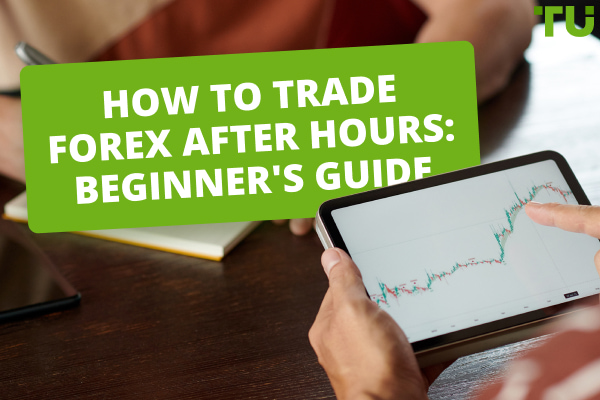5 Long-Term Forex Trading Strategies to Know
Top 5 position trading Forex strategies:
Support and resistance trading strategy to manage long-term position
Moving averages crossover strategy to follow detected macro trends
Trend reversal strategy to identify potential reversals and adjust their positions accordingly
Breakout trading for capitalizing on significant price movements
Carry trading involves taking advantage of interest rate differentials between two currencies
Position trading is a highly favorable approach for long-term Forex investors due to its potential for substantial profits and reduced transaction costs. By focusing on long-term trends, position traders can ride the wave of market momentum and capture significant price movements.
This article aims to provide insights into the concept of position trading and explore five effective strategies to consider. By understanding these strategies, traders can make informed decisions and capitalize on long-term trends to achieve their investment goals.
What is Forex Position Trading?
Forex position trading strategies involve holding positions for an extended period, often months or even years, to take advantage of long-term trends. Forex position traders rely on a combination of fundamental macro analysis and technical analysis to identify key points and trends. This approach requires a deep understanding of fundamental data and the ability to analyze macroeconomic factors that influence currency movements.
This trading style allows investors to avoid the noise and volatility associated with short-term trading, providing a more relaxed and less time-intensive trading experience. The extended holding periods of position trading provide the opportunity to capitalize on fundamental macroeconomic factors that drive currency movements, enabling traders to make more informed and strategic decisions.
👍 Pros of Position Trading
• Position trading allows investors to capture significant price movements and potentially generate substantial profits by riding long-term trends
• Reduced Transaction Costs. Holding positions for extended periods reduces the frequency of trades, resulting in lower transaction costs, such as spreads and commissions, compared to shorter-term trading styles
• Requires less time and active monitoring compared to shorter-term trading styles, allowing traders to pursue other interests or occupations
• Traders have the opportunity to incorporate fundamental analysis and macroeconomic factors, giving them a deeper understanding of the market and potentially enhancing their trading decisions
• This trading style reduces the impact of short-term market fluctuations and noise, providing a more relaxed trading experience and allowing traders to make informed decisions based on longer-term trends
👎 Cons of Position Trading
• Holding positions for extended periods exposes traders to larger potential drawdowns, and it may take longer to recover from losses compared to shorter-term trading styles
• Position trading involves fewer trades, potentially resulting in a slower accumulation of profits and limiting opportunities for those who prefer a higher level of activity in their tradin
• Position trading demands a high level of patience and discipline to stay committed to trades during longer holding periods and avoid succumbing to impulsive decision-making or emotional biases
5 Forex position trading strategies to know
Let’s consider the top 5 useful position trading strategies:
Macro trend support and resistance strategy
Position traders use macro trends' support and resistance levels to manage their portfolios. They analyze long-term charts and fundamental macroeconomic factors to identify key points for opening and reducing positions.
When price approaches the support level, position traders may consider opening new positions or adding to existing ones, anticipating a potential bounce or reversal. Conversely, when price approaches a resistance level, traders may look to reduce or exit positions, expecting a potential price reversal or pullback.
An example of a position trading scenario could involve macro traders buying the Dollar Index (DXY) in February 2022 following a breakout above its 200-week moving average (MA). The trader's conviction in the dollar's strength was bolstered by the expectation of a looming tight monetary policy by the Federal Reserve (FED), indicating potential intensive interest rate hikes that are considered as an extra positive factor for the US Dollar.
| Meeting date | Rate change | Target range |
|---|---|---|
|
March 15-16, 2022 |
Assets for copy trading
+25 basis points |
Regulator
0.25-0.5 percent |
|
May 3-4, 2022 |
Assets for copy trading
+50 basis points |
Regulator
0.75-1 percent |
|
June 14-15, 2022 |
Assets for copy trading
+75 basis points |
Regulator
1.50-1.75 percent |
|
July 26-27, 2022 |
Assets for copy trading
+75 basis points |
Regulator
2.25-2.5 percent |
|
Sept. 20-21, 2022 |
Assets for copy trading
+75 basis points |
Regulator
3-3.25 percent |
|
Nov. 1-2, 2022 |
Assets for copy trading
+75 basis points |
Regulator
3.75-4 percent |
|
Dec. 13-14, 2022 |
Assets for copy trading
+50 basis points |
Regulator
4.25-4.5 percent |
Source: Fed’s board of governors:
Over the subsequent months, as the DXY continues to climb, the traders periodically rebalance their positions to manage risk and lock in profits. This strategy allows them to capture the extended upward trend in the DXY until November 2022, taking advantage of the sustained strength in the US dollar against a basket of major currencies.
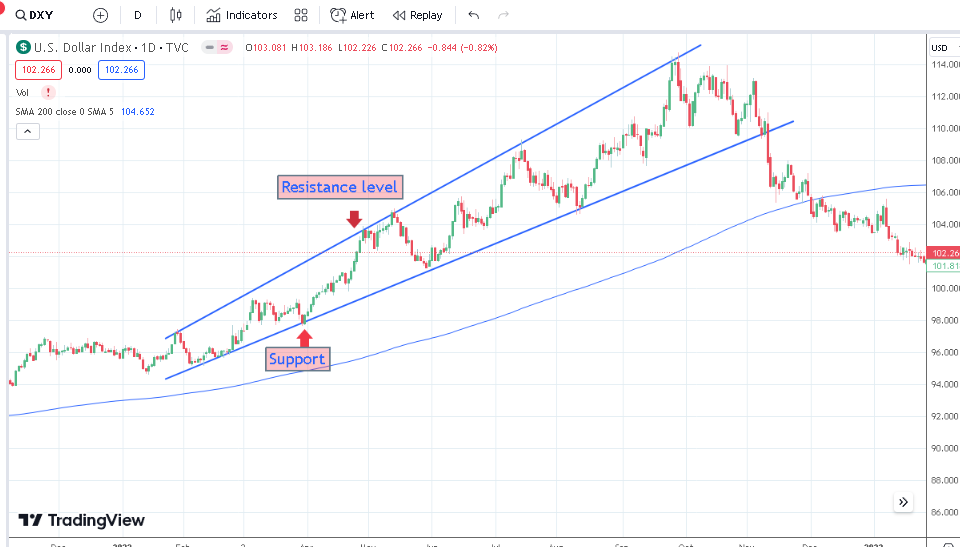
Dollar Index (DXY) chart - Position trading support and resistance
Trend following strategy with Moving Averages
Moving averages are actively used by many traders to follow detected macro trends. They often use daily and weekly time frames and specific moving average setups to confirm trends and make trading decisions.
For example a position trader can use a 50-day and a 200-day moving average crossover on the daily chart. When the shorter-term moving average crosses above the longer-term one, it confirms an upward macro trend and prompts the trader to enter a long position.
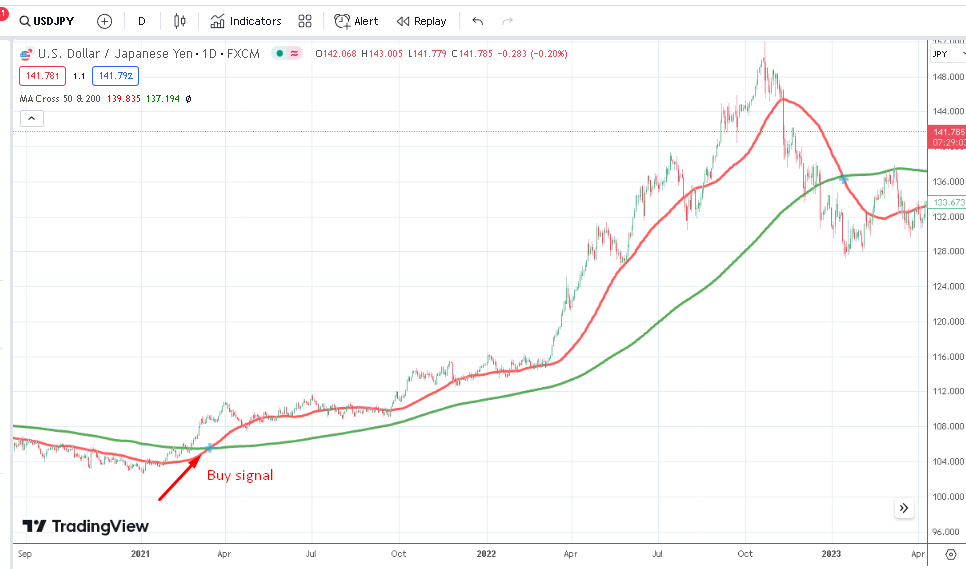
USD/JPY position trading buy signal
Macro trend reversal strategy
Position traders actively look for trend reversals on macro charts. They use specific chart patterns and indicators to identify potential reversals and adjust their positions accordingly.
For example, a position trader identifies a currency pair forming a double top pattern on the weekly/monthly chart. This indicates a potential trend reversal from bullish to bearish, prompting the trader to consider reducing or exiting long positions.
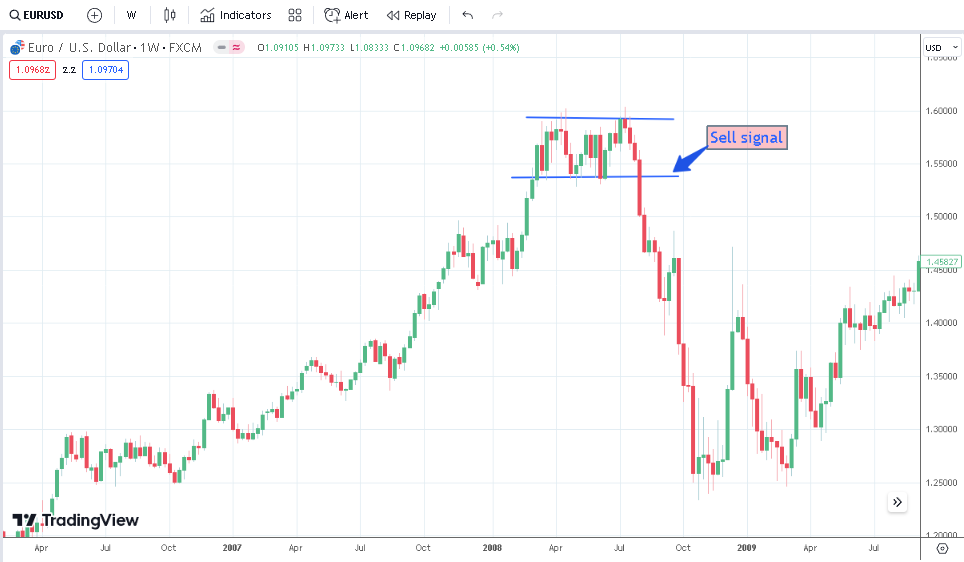
EUR/USD macro trend reversal signal
Position traders typically consider various macroeconomic signals to validate trend reversal patterns. These traders analyze fundamental data and macroeconomic indicators to gauge the health of an economy and assess potential shifts in market sentiment. They look for signals such as changes in interest rates, inflation rates, employment figures, GDP growth, and geopolitical developments. By combining technical analysis with a deep understanding of these macroeconomic factors, position traders gain valuable insights into the underlying economic dynamics that could drive trend reversals.
Breakout Trading Strategy
Breakout trading is a popular position trading strategy that involves identifying and capitalizing on significant price movements when an asset breaks out of a well-defined range or consolidation phase. Position traders seek to take advantage of these breakout opportunities, which often indicate the potential for a new trend to develop.
To implement this strategy, traders monitor price charts and look for instances where the price breaks above resistance or below support levels with substantial volume and momentum. The breakout is seen as a signal that the asset's price is likely to continue moving in the same direction, providing a trading opportunity.
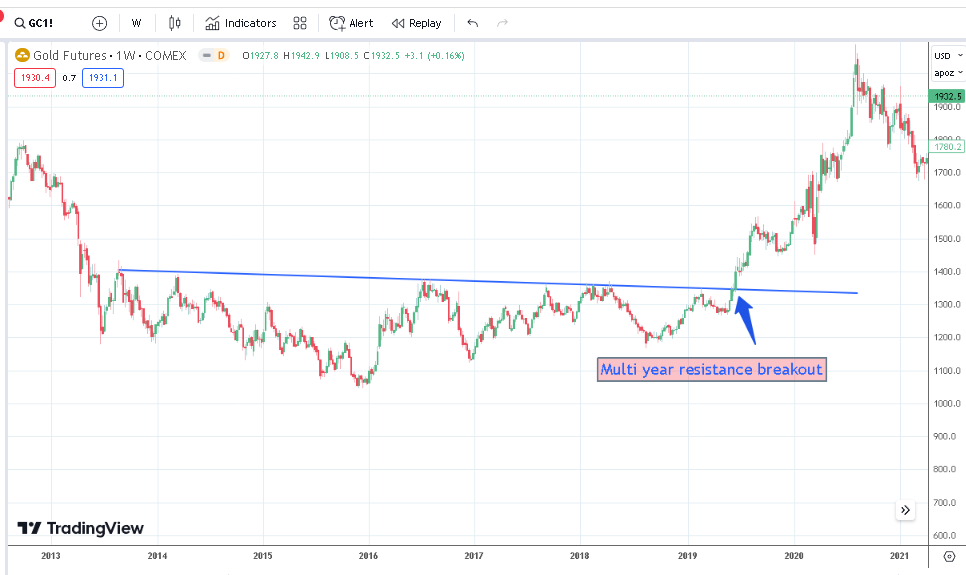
Breakout position trading strategy
Carry Trading
Carry trading involves taking advantage of interest rate differentials between two currencies. Position traders can employ carry trades as a long-term, low-risk trading strategy, focusing on earning interest income while benefiting from potential currency appreciation.
Example. A position trader borrows a low-interest-rate currency and invests in a higher-interest-rate currency. They hold the position for an extended period, aiming to profit from both the interest rate differential and potential currency appreciation.
Is Position Trading Good for Me?
Position trading requires specific skills and resources. Traders considering position trading should possess the following:
Patience. Position trading involves holding trades for extended periods, so patience is crucial
Sufficient Capital. Position traders need enough capital to withstand potential drawdowns and hold positions for an extended period
Risk Management. Effective risk management is vital for position traders to protect their capital and manage potential losses
Fundamental Analysis Skill. Position traders must have a deep understanding of fundamental data and macroeconomic factors that influence currency movements
Technical Analysis Skills. Position traders should be proficient in technical analysis to identify trends, key levels, and potential entry and exit points
Discipline. Position trading requires discipline to stick to the trading plan and avoid impulsive decisions based on short-term market fluctuations
Position Trading and Forex Fundamental Data
To successfully engage in position trading, it is crucial to understand key fundamental analysis factors that influence Forex macro trends. Here are six fundamental parameters traders should understand well:
Monetary Policy Decisions made by central banks, such as interest rate changes or quantitative easing programs, have a profound effect on currency values. Traders should closely monitor central bank announcements and statements. If a central bank implements expansionary monetary policy, such as reducing interest rates or implementing quantitative easing, it can potentially weaken the currency
Inflation (CPI - Consumer Price Index) Inflation measures the increase in the general price level of goods and services over time. High inflation can erode the purchasing power of a currency, while low inflation may increase its attractiveness. On the other hand, when there is high inflation, central banks may respond by initiating rate hikes, which can be viewed as positive for the currency. So, traders should understand the context and weigh different factors
Labor Market Data such as employment figures, unemployment rates, and wage growth, provide insights into a country's economic health. Positive labor market data can boost a currency's value, while weak data may have the opposite effect
Trade Balance. The trade balance measures the difference between a country's exports and imports. A positive trade balance (surplus) indicates that exports exceed imports, contributing to currency strength, while a negative balance (deficit) may weaken the currency
Political and geopolitical events such as elections, policy changes, or international conflicts, can significantly impact currency movements. Traders need to stay informed about such developments and analyze their potential impact on Forex markets
By understanding these fundamental analysis factors and monitoring their developments, position traders can make informed decisions and identify long-term trends in the Forex market.
Remember, position trading requires careful analysis, proper risk management, and a disciplined approach. Successful position traders combine their fundamental analysis skills with technical analysis tools to make well-informed trading decisions based on long-term trends and market conditions.
Position trading and Forex swaps
Forex position trading has some important differences with stock position trading. One of the most important factors is Forex swaps. Here's how Forex swaps can affect position traders:
Carry Trade Considerations. Position traders who engage in carry trades, where they borrow a low-interest-rate currency to invest in a higher-interest-rate currency, may utilize Forex swaps to roll over their positions. Swaps allow them to extend the duration of their positions and manage the interest rate differentials between the two currencies. The cost or benefit of the swap can impact the overall profitability of the carry trade
Rollover Costs. Position traders holding positions overnight or for an extended period may be subject to rollover costs. These costs are associated with the interest rate differentials between the currencies being traded and are reflected in the Forex swap rates. Traders need to factor in these costs when calculating potential returns and managing their positions
It's important for position traders to monitor and understand the implications of Forex swaps, including rollover costs and interest rate differentials. By considering these factors, position traders can make informed decisions regarding their trading strategies and effectively manage their long-term positions in the Forex market.
Position Trading vs Swing Trading
Comparison Table:
| Parameters | Position Trading | Swing Trading |
|---|---|---|
Understanding Economic Data |
Assets for copy trading Deep understanding required |
Regulator Moderate understanding required |
Position Holding Periods |
Assets for copy trading Months to years |
Regulator Days to weeks |
Overall Risk Level |
Assets for copy trading Lower risk due to longer-term focus |
Regulator Higher risk due to shorter-term focus |
Potential Profitability |
Assets for copy trading Potential for larger profits |
Regulator Potential for smaller but frequent profits |
In summary, position trading involves a longer time horizon, focusing on capturing long-term trends and utilizing macroeconomic data. It requires a high level of patience, lower trade frequency, and a deep understanding of economic fundamentals. The risk level is relatively lower due to the longer-term perspective.
On the other hand, swing trading involves shorter holding periods, aiming to capture shorter-term price swings. It combines counter-trend and trend-following strategies, relying on technical analysis and price patterns. Swing trading requires a moderate understanding of economic data, higher trade frequency, and active risk management to navigate the shorter-term market dynamics.
FAQs
How long can I hold a position in Forex?
As a position trader in Forex, you have the flexibility to hold positions for an extended period, typically ranging from several weeks to months or even years. The specific duration of holding a position will depend on your trading strategy, market conditions, and the strength of the identified trend, allowing you to capitalize on longer-term market movements.
Is position trading profitable?
Position trading can be profitable for traders who effectively identify and capitalize on long-term trends. By taking a patient and strategic approach, position traders have the potential to capture significant price movements and generate substantial profits. However, success in position trading relies on proper risk management, thorough analysis of market conditions, and a disciplined trading strategy.
Which time frame is best for position trading?
The best time frame for position trading typically involves higher time frames, such as daily, weekly, or even monthly charts. These longer time frames provide a broader perspective of market trends, allowing position traders to identify and capitalize on significant price movements that unfold over extended periods, aligning with the goals and strategies of position trading.
Team that worked on the article
Andrey Mastykin is an experienced author, editor, and content strategist who has been with Traders Union since 2020. As an editor, he is meticulous about fact-checking and ensuring the accuracy of all information published on the Traders Union platform. Andrey focuses on educating readers about the potential rewards and risks involved in trading financial markets.
He firmly believes that passive investing is a more suitable strategy for most individuals. Andrey's conservative approach and focus on risk management resonate with many readers, making him a trusted source of financial information.
Dr. BJ Johnson is a PhD in English Language and an editor with over 15 years of experience. He earned his degree in English Language in the U.S and the UK. In 2020, Dr. Johnson joined the Traders Union team. Since then, he has created over 100 exclusive articles and edited over 300 articles of other authors.
The topics he covers include trading signals, cryptocurrencies, Forex brokers, stock brokers, expert advisors, binary options. He has also worked on the ratings of brokers and many other materials.
Dr. BJ Johnson’s motto: It always seems impossible until it’s done. You can do it.
Mirjan Hipolito is a journalist and news editor at Traders Union. She is an expert crypto writer with five years of experience in the financial markets. Her specialties are daily market news, price predictions, and Initial Coin Offerings (ICO). Mirjan is a cryptocurrency and stock trader. This deep understanding of the finance sector allows her to create informative and engaging content that helps readers easily navigate the complexities of the crypto world.




